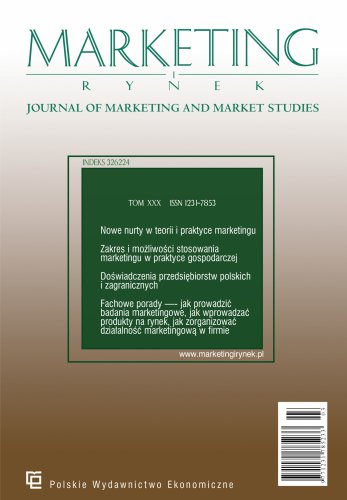Purpose branding in times of change and uncertainty – utopia or strategic forethought?
The change is an immanent element of the modern business environment, however the change itself is not the reason of the companies' collapse. The reason for failure is strategic myopia as well as the organization's inability to address these alterations. Purpose branding is a response to the challenges of the modern business environment and an opportunity to make the organization resilient to current market shocks and turbulences. The aim of the article is to identify the extent to which organisations are ready to use purpose branding on the Polish market, especially in relation to the idea of sustainable development. The empirical basis are the results of the research conducted in Poland, in November 2022 on a group of 89 marketing managers with the use of the CAWI method. The research has shown that there is a strong relationship between purpose branding and the competitive advantage of an organization. Moreover, currently, the scope of building of brands based on values is quite limited. Currently, large organizations operating in traditional channel are recognized as those which the most widely used brands built on values. However, the biggest "turnaround" will be made in case of small organizations for which the digital channel is the dominant source of revenue. At the same time, the Polish marketers declare to intensify usage of purpose branding in the nearest future.
References
Bibliografia/References
Adamson, A., & Steckel, J. (2018). Shift Ahead How the Best Companies Stay Relevant in a Fast-Changing World. AMACOM.
Ansoff, H. I. (1979). Strategic Management. Macmillan.
Barney, J. (1991). Firm resources and sustained competitive advantage. Journal of Management, 17(1), 99–120. https://doi.org/10.1177/014920639101700108
Berry, L. L. (1995). Relationship marketing of services – growing interest, emerging perspectives. Journal of Academy of Marketing Science, 23(4). https://doi.org/10.1177/009207039502300402
Bratnicki, M., Kryś, R., & Stachowicz, J. (1988). Kultura organizacyjna przedsiębiorstw. Ossolineum.
Chesbrough, H. (2006). Open Business Models: How to Thrive In The New Innovation Landscape. Harvard Business Review Press.
Christensen, C. M. (1997). The Innovator's Dilemma – When New Technologies Cause Great Firms to Fail. Harvard Business Review Press.
Colvile, R. (2017). The Great Acceleration – How the World is Getting Faster, Faster. Bloomsbury.
Czakon, W. (2020). Krótkowzroczność strategiczna menedżerów. Wydawnictwo Uniwersytetu Jagielońskiego.
Cyfert, Sz. (2014). System granic architektury procesów organizacji – determinanty kształtowania i dysfunkcje w definiowaniu. Prace Naukowe Uniwersytetu Ekonomicznego we Wrocławiu, (340 – Nowe kierunki w zarządzaniu przedsiębiorstwem – wiodące orientacje), 243–250. https://doi.org/10.15611/pn.2014.340.22
Diamandis, P. H., & Kotler, S. (2020). The Future is Faster than you Think – How Converging Technologies Are Transforming Business, Industries, and Our Lives. Simon & Schuster. https://doi.org/10.1080/15228053.2022.2101088
Doyle, P. (2000). Value-Based Marketing – Marketing Strategies for Corporate Growth and Shareholder Value. Wiley.
Doyle, P. (2008). Value-Based Marketing – Marketing Strategies for Corporate Growth and Shareholder Value. Wiley.
Dziamski, S. (1981). Aksjologia, estetyka, etyka. Wydawnictwo Naukowe PWN.
Echeverria, L. M. (2012). Idea Agent – Leadership that Liberates Creativity and Accelerates Innovation. AMACOM.
Emery, F. E., & Trist, E. L. (1965). The causal texture of organizational environments. Human Relations, 18(1), 72–82. https://doi.org/10.1177/001872676501800103
Fesser, C. (2011). Serial Innovators – Firms that Change the World. Wiley.
Foster, R., & Kaplan, S. (2003). Twórcza destrukcja – dlaczego firmy nastawione na stopniowe ulepszanie swojej działalności nie mają szans przetrwać i jak je skutecznie przekształcać. Wydawnictwo Galaktyka.
Gronroos, Ch. (1997). Value-driven relationship marketing – from products to resources and competencies. Journal of Marketing, 13(5).
Grzegorczyk, K. (1971). O pojęciu wartości w antropologii kulturowej. Studia Socjologiczne, (1/40).
Hempoliński, M. (1974). Brytyjska filozofia analityczna. Wiedza Powszechna.
Hostede, G. (1983). The cultural relativity of organizational practices and theories. Journal of International Business, 14.
Holbeche, L. (2015). The Agile Organization – How to Build and Innovative, Sustainable and Resilient Business. Kogan Page.
IBM. (2010). Capitalising on Complexity – Insights from the Global Chief Executive Officer Study, IBM & Reinventing the Rules of Engagements – CEO Insights from the Global C-suite Study. IBM Institute for Business Value.
Kaplan, S. (2012). The Business Model Innovation Factory. Wiley.
Kelly, K. (2017). The Inevitable. Understanding 12 Technological Forces That Will Shape Our Future. Penguin.
Kozielski, R. (2022). Rynkowa due diligence – pomiar odporności rynkowej organizacji. Wydawnictwo Naukowe PWN.
Lachowski, S. (2013a). Droga ważniejsza niż cel. Studio Emka.
Lachowski, S. (2013). Od wartości do działania – przywództwo w czasach przełomowych. Studio Emka.
Levitt, T. (1960). Marketing Myopia. Harvard Business Review. (38/July–August), 24–47.
Makota, J. (2010). Filozofia wartości według Hugona Münsterberga. Estetyka i Krytyka, 19(2).
Markides, C. C. (2021). Organizing for the New Normal: Prepare Your Company for the Journey of Continuous Disruption. Kogan Page.
Martin, J., & Petty, W. (2000). Value Based Management. Oxford University Press.
Mazurek, G. (2019). Transformacja cyfrowa – perspektywa marketingu. Wydawnictwo Naukowe PWN.
McKinney, Ph. (2012). Beyond the Obvious: Killer Questions That Spark Game-Changing Innovation. Hachette Books.
Misztal, M. (1980). Problematyka wartości w socjologii. PWN.
Peters, T. J. (1988). Thriving on Chaos – Handbook for a Management Revolution. Harper Perennial.
Pogorzelski, J. (2019). Marka na cztery sposoby. Wydawnictwo Nieoczywiste.
Post, J. E., Preston L. E., & Sachs, S. (2002). Redefining the Corporation. Stakeholder Management and Organizational Wealth. Stanford University Press. https://doi.org/10.1515/9781503619692
Ross, A. (2016). Industries of the Future. Simon & Schuster.
Rudawska, E. (2008). Znaczenie relacji z klientami w procesie kształtowania wartości przedsiębiorstwa. Wydawnictwo Naukowe Uniwersytetu Szczecińskiego.
Sikorski, Cz. (2008). Kultura organizacyjna. C.H.Beck.
Sinek, S. (2011). Start with Why: How Great Leaders Inspire Everyone to Take Action. Penguin.
Stengel, J. (2012). Grow – How Ideals Power Growth and Profit at the World's 50 Greatest Companies. Virgin Books.
Thiel, P., & Masters, B. (2015). Zero to One. Virigin Books.
Thompson, D. G. (2006). Blueprint to a Billion. Wiley.
Wankel, Ch. (2008). 21st Century Management – A Reference Handbook. Sage Publications.
Watson, D. (2005). Business Models – Investing in Companies and Sectors with Strong Competitive Advantage. Harriman House.

